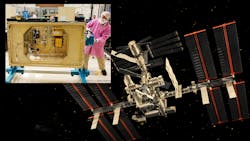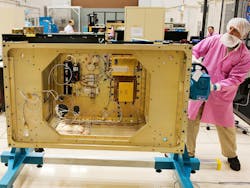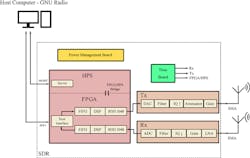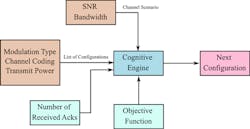Space-Based SDR: NASA’s SCaN Testbed
This article is part of the TechXchange: Software-Defined Radio and TechXchange: Antenna Design.
Members can download this article in PDF format.
What you’ll learn:
- Challenges with traditional radio systems in space.
- What is the SCaN Testbed?
- Data, insights, and solutions gathered and generated from the STB over the past seven years.
Developing electronics for space applications is certainly an exciting task, but it can become a real problem if the designer fails to address the critical robustness requirements of the application. It’s crucial to consider not only the harsh environment of space, but also the fact that physical maintenance is very scarce and expensive. Therefore, it’s not a surprise that RF devices for space communication are evolving from fixed and single-purpose hardware-based systems to flexible, robust, and reprogrammable software-defined radios (SDRs).
To ensure proper operation in space, SDRs must be prepared to endure harsh conditions. Thus, they must employ radiation-hardened electronics; comply with limited size, weight, and power (SWaP) requirements; and allow for remote control and programming from ground stations. To verify the feasibility of using SDRs in space, experiments ensued in the SCaN (Space Communications and Navigation) testbed (Fig. 1).
In this article, we discuss the main findings obtained from the SCaN study, which include the many benefits of using SDRs and how these devices are selected for space-based applications. We focus on a set of properties that are found in high-end and custom SDRs, including radiation resistance, reduced SWaP specifications, modularity, RF performance, and the ability to be programmed and reconfigured from ground stations.
The programming and reconfigurability allows for updating and uploading waveforms while in orbit, simplifying the transition of waveforms to new platforms, changing tuning frequencies on-the-fly, reducing the overall complexity of the system by implementing multiple programmable tasks, and providing the high-data-rate (Ka-band) communications required in low-Earth-orbit (LEO) missions.
Traditional Radio Systems in Space
In general, spacecraft can be considered as two basic sections: the platform and the payload. The platform, which is responsible for supporting the payload into space, comprises five functional subsystems:
- Structural
- Telemetry, tracking, and command (TT&C)
- Electric power and distribution
- Thermal control
- Altitude and velocity control
In our discussion, we focus on the TT&C subsystem, which includes receivers, transmitters, antennas, and sensors for a variety of measurements, such as temperature, pressure, voltages, and currents. The payload is the equipment that performs the primary mission of the spacecraft. In telecommunication systems, for instance, the payload consists of antennas, transceivers, low-noise amplifiers (LNAs), mixers, local oscillators, modulators and demodulators, and power amplifiers.
Naturally, the harsh conditions of space create a difficult environment for electronics in general. First, the mechanical vibration generated by the rocket launch is tremendous, which may damage or interfere with electronics that aren’t well designed. Another issue is related to plastic outgassing, which generates vapors that can deposit material on devices (especially optical windows) and consequently degrade performance.
Furthermore, heat dissipation is a major challenge, as the vacuum of space impedes dissipation of the heat generated by electronics, as heat can only travel through vacuum by radiation. Insufficient heat dissipation can significantly reduce the life expectancy and performance of electronic systems. Finally, since the space environment isn’t protected by the Earth’s atmosphere, the spacecraft must endure a dangerous amount of radiation, which can damage electronics and affect their performance, often leading to complete failure.
If the space environment isn’t kind to electronic components in general, it’s even worse for RF devices. Because any operation regarding space missions is performed remotely, wireless communications are important for any function, making robust transceivers crucial. Also, the available electromagnetic spectrum is significantly limited and therefore makes them prone to interference and channel saturation. Therefore, traditional RF systems aren’t going to be enough to handle the huge amounts of data required for the future of space-based communications.
Furthermore, fixed and hardware-based systems can’t account for changes in the mission conditions and priorities, as the hardware can be difficult to change. Novel solutions will require a huge level of flexibility, allowing for remote configuration and generation of waveforms, modulation schemes, bandwidths, and tuning frequencies. Thus, software-based systems are much more adequate—programs can be easily transmitted through wireless links.
In this context, SDRs can help solve most of the RF problems regarding space missions due to their high level of reconfigurability and flexibility. SDRs are composed of two main stages: a radio front end (RFE) to handle all analog operations, and a digital back end (Fig. 2).
The RFE performs all of the Tx and Rx operations, including amplifiers, filters, mixers, and antenna coupling circuits. It’s designed to receive and transmit signals over a wide tuning range, into the Ka-band. State-of-the-art SDRs can reach up to 3 GHz of bandwidth over multiple radio chains, providing multiple-input, multiple-output (MIMO) operation with independent analog-to-digital and digital-to-analog converter (ADC/DAC) blocks for each channel.
The digital backend, on the other hand, performs all digital-signal-processing (DSP) functions, including modulation/demodulation schemes, up/downconverting, and data packaging. It’s implemented using a high-end FPGA, which can be reprogrammed and configured on-the-fly to perform complex DSP algorithms and the latest radio protocols, with minimum latency.
The digital backend can be easily integrated into host computers and networks via Ethernet links. Consequently, they’re compatible with networked ground stations and RF processing software, such as GNU Radio. Finally, the modularity of SDRs also allows them to be designed for a variety of SWaP requirements, both for critical on-board missions and large ground stations.
The SCaN Testbed
The Space Communication and Navigation (SCaN) testbed was a testing platform implemented aboard the International Space Station (ISS) to perform both software and hardware functionalities of SDRs, as well as RF applications, using NASA's Space Telecommunications Radio System (STRS) standard architecture (Fig. 3). It has two S-band SDRs, one of which uses GPS, and one Ka-band SDR.
The SCaN testbed (STB) focused particularly on interfacing SDR basic functions; advanced networking technology; spectrum-efficient technology; and Position, Navigation and Time (PNT) protocols. It flew on the ISS for seven years, performing more than 4,200 hours of testing, and was decommissioned on June 3, 2019.
The STB was designed and deployed to create a readily available SDR platform to implement and test space radio systems. One of its main missions was to advance our understanding of the SDR specifications required to operate in space applications, including waveform repositories, communication protocols, design standards, and software tools. It also was responsible for conducting experiments regarding device interoperability, networking, navigation, and technological challenges faced by these SDRs.
Furthermore, the SCaN testbed helped in training and educating several waveform developers, resulting in the creation of extensive waveform repositories. Finally, the STB was used to validate the capabilities of S-band, K-band, and GPS missions before deployment.
Generally, and especially in space applications, SDRs are becoming the main building blocks of RF testbeds. This is due to the high level of flexibility introduced by these devices, which allows functions to be modified within the same device without any hardware modification. This enables work with different communication protocols, modulation schemes, and RF capabilities.
Because SDRs are able to be reprogrammed over the air, the entire testbed can be upgraded or modified in orbit and the latest RF protocols and algorithms may be implemented, while providing a means for remote failure correction. Hardware standardization is another a great advantage, as general-purpose SDRs can be tailored to work with specific RF applications by simply running software on top of standard hardware, which is already stable and well validated.
SDRs are compatible with open-source host software, including GNU Radio. Therefore, the testbed may be used not only by large companies, but also by students and researchers from engineering universities.
Over the years, the STB helped in the accomplishment of several research milestones in the SDR field. One of its main contributions was in the development of the STRS standard for SDRs. The STRS standard was developed by NASA to enable portability of RF software to novel SDR platforms, reducing the development time and risk.
By complying with the standard, third-party software developers can make use of extensive waveform repositories and design on top of existing open-source platforms without needing to worry about the hardware underneath. The STB was a crucial tool in the development of waveforms and reusable software components for the STRS repository, letting future missions simply reuse the software pieces already developed.
In addition, the STB was fundamental in the operation of the first Ka-band NASA mission with the Tracking and Data Relay Satellite System (TDRSS). In this case, the STB was used to implement a full-duplex space transceiver able to validate Ka-band performance of TDRS satellites and test several communication upgrades on research projects, such as the Space Network Ground Segment Sustainment (SGSS) and the User Service Subsystem Component Replacement (USS-CR).
Another demonstration of the flexibility of the STB came in 2018: The STB became the first in-orbit device to use the European Galileo E5A navigation signal, which combines GPS and Galileo signals to increase the precision in spacecraft orbit determination.
The STB was able to validate in-orbit reconfiguration of space RF systems by performing 888 reconfiguration routines, which is an incredible achievement in a field where a single maintenance routine is a high-risk endeavor.
Other applications of the STB include cognitive radio and adaptative waveforms, which are applied in signal sensing and environment awareness; spectrum- and power-efficiency techniques, which require new modulation schemes and coding; and GPS/GNSS demonstrations, involving L1/L2, l5, GPS augmentation, jammer detectors, and scintillation. The STB was extensively used in networking tests, including disruptive tolerant networking, adaptive routing, secure routing, and formation flying.
A Glimpse of the Future
The huge amount of data and insights obtained from the STB in its seven years of operation is driving important research in the space RF field. Cognitive radio is one of the frontlines in communication technology, implementing artificial-intelligence and machine-learning (AI/ML) algorithms to configure and tune the RF parameters of the channel, allowing for fast and automatic adaptation to environmental conditions.
The feasibility of implementing cognitive radio in space SDRs was demonstrated in 2018, when an AI/ML-based algorithm was used in the STB for automatic communication service scheduling, enabling the platform to request high-rate services almost in real-time. The algorithms were performed using GNU Radio, an open-source software development framework for RF applications. Figure 4 shows the basic framework implemented in the 2018 study, as described in Shahidullah et al.1
Currently, cognitive radio research is being developed by NASA’S Cognitive Communications Project. The information obtained from the STB is being used to improve space radio performance and resiliency through AI/ML algorithms.
Besides the many challenges that were alleviated by the software-based nature of the SCaN testbed, SDRs can still bring many benefits to space radio systems. First, the SDR components can be radiation-hardened, which is fundamental to ensure robust operation in the harsh environment of space. Digital systems enable the use of error-correction algorithms to implement logical radiation hardening, which employs redundant techniques to provide another layer of protection to the collected data.
Furthermore, MIMO SDRs can perform several tasks simultaneously, which significantly reduces the total equipment count and overall complexity, relaxing the SWaP conditions. To be used in space, SDRs must be qualified via thermal, vacuum, and vibration tests.
Conclusion
The design of space electronics has never been easy, especially for RF applications. The challenges regarding maintenance, robustness, performance, and upgradability of traditional radio systems resulted in many technological limitations for the space industry, as virtually every function in a spacecraft relies on RF communications. Software-based systems and especially SDRs, are providing a tremendous paradigm shift in RF technology, providing a whole new level of flexibility and robustness by performing most of the radio functions in the digital domain.
In this context, the SCaN testbed was essential in the development and validation of new radio algorithms and techniques, demonstrating the potential of SDR-based systems in this field. Experiments in the SCaN showed that SDR-based systems provide much more interoperability, upgradability, and adaptability when compared to traditional systems. That’s because the digital back end can be completely reprogrammed remotely without any hardware replacement.
The information obtained from the STB experiments is paving the way for the future of space radio, with cognitive communication systems combining SDRs with AI/ML to improve performance and resilience of RF units.
Read more articles in the TechXchange: Software-Defined Radio and TechXchange: Antenna Design.
Reference
1. Shahidullah, A., Asadi, H., Volos, H., Ryu, B., Bose, T., Reinhart, R., & Briones, J. (2015, March). Cognitive radio experiment design for the space communications and navigation (SCaN) Testbed. In Proceedings of SDRWInnComm 2015 wireless innovation conference on wireless communications technologies and software defined radio (pp. 16-23).
About the Author
Brendon McHugh
Field Application Engineer & Technical Writer, Per Vices Corp.
Brendon McHugh is a field application engineer and technical writer at Per Vices, which has extensive experience in developing, building, and integrating software-defined radios. Brendon is responsible for assisting current and prospective clients in configuring the right SDR solutions for their unique needs. He holds a degree in theoretical and mathematical physics from the University of Toronto.




